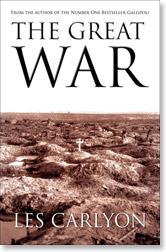Les Carlyon was born in Northern Victoria in 1942. He has been editor of the Melbourne Age, editor-in-chief of the Herald and Weekly Times group and visiting lecturer in journalism at RMIT in a career that has established him as one of Australia’s most respected journalists. He has received both the Walkley Award (twice) and the Graham Perkin Australian Journalist of the Year Award.
The Great War
History at its most compelling
History at its most compelling

Genre:
AFTER THE CRITICAL ACCLAIM and enormous success of Gallipoli, Les Carlyon has broadened his scope to produce the definitive Australian account of the First World War and the Anzacs on the Western Front. From the power plays in the palaces of Europe, to the stench of rotting flesh in the trenches, Carlyon covers the entire scope of this most terrible of wars.
With incredibly detailed research, he tells not just the story of the war, but also the story of the men and women involved. It is a totally engrossing narrative on how and why an entire generation of Australians were lost in battlefields thousands of miles away. The impact of the war on their lives and the lives of those left behind is told with such insight, you could believe Les Carlyon himself was in those trenches 90 years ago.
This towering achievement is ideal reading for anyone interested in Australian history.






